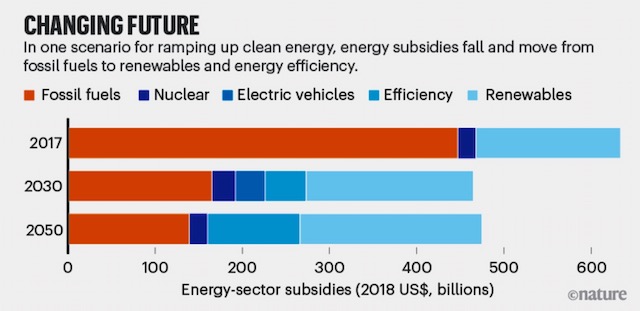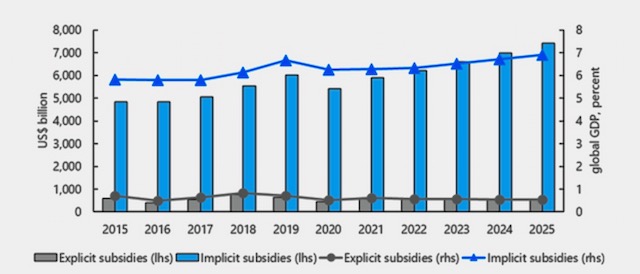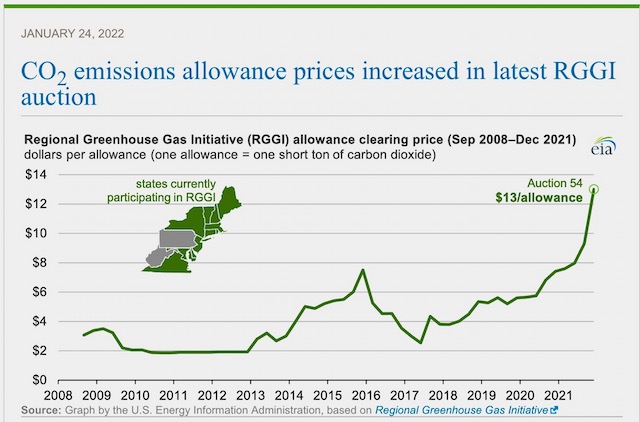NJ Spotlights Gets It All Wrong On The Economics Of Climate And Energy, Again!
Fossil Fuels And Nukes Get Huge Subsidies
The Costs Of Climate Chaos Are Ignored
NJ Climate Activists Are Lame And Corrupted
NJ Spotlight – with an assist from terrible “expert” sources – wrote another hit piece on so called “high costs” of the “subsidies” to renewable energy.
Today’s story is another in a years long campaign – which just so happens to align with the economic interests of their corporate and elite Foundation “major donors” like PSEG – of attacking renewable energy and exaggerating so called “subsides”, while ignoring fossil subsidies and the costs of the climate emergency, known as the “Social Costs Of Carbon”.
I’ll just post a few graphs and links to research Reports and DEP data to illustrate the flaws in Spotlight’s upside down thinking:
1. The International Monetary Fund (IMF) estimates that fossil fuels receive $5.9 TRILLION /yr in subsidies. Have you ever read that?
Globally, fossil fuel subsidies are were $5.9 trillion or 6.8 percent of GDP in 2020 and are expected to increase to 7.4 percent of GDP in 2025 as the share of fuel consumption in emerging markets (where price gaps are generally larger) continues to climb. Just 8 percent of the 2020 subsidy reflects undercharging for supply costs (explicit subsidies) and 92 percent for undercharging for environmental costs and foregone consumption taxes (implicit subsidies).
2. A recent study estimate that the “Social Cost of Carbon” (SCC) is $185 per ton. Have you read about that?
3. In comparison to the SCC, the price of an “allowance” to emit one ton of carbon under the Regional Greenhouse Gas Initiative (RGGI) is just $13 per ton. Have you read about that?
(the Y axis on this graph would need to be significantly increased to show SSC $185/ton, and that would illustrate how small the RGGI price is, instead of how this graph makes it appear to be rising sharply)
4. According to the most recent DEP emission inventory, NJ polluters emit about 100 million tons of carbon equivalents per year.
5. DEP mandates air pollution emissions fees. The current DEP air pollutant emission fee is about $125/ton, but the fee does not apply emissions of greenhouse gases. Have you read about that?
6. If the Social Cost of Carbon is used ($185/ton) and compared to the RGGI allowance price ($13/ton), greenhouse gas polluters receive huge subsidies, about $17 billion per year. Ever read that?
7. If the DEP air emissions fee is used ($125/ton) and compared to the RGGI allowance price ($13/ton), then greenhouse gas polluters receive huge subsidies, about $11 billion per year.
8. Studies have examined how to reduce these fossil subsidies and shift them to conservation and renewables. Such as shift can be achieved by changes in public policy and regulation (see above chart:
9. Back in the 1980’s, in order to promote garbage incineration, NJ provided similar huge subsidies, over $200 million/year to “resource recovery”. Ever read about that?
When Gov. Florio changed DEP policy to discourage incinerations and promote waste reduction and recycling, those incineration subsidies were shifted to local and country recycling programs. Did the news ever report that? Or that it could be repeated today on energy?
10. The Murphy BPU and the DEP could implement a similar shift in subsidies from fossil to conservation and renewables by using their current statutory authority to regulate public utilities and the environment.
BPU could eliminate fossil subsides and impose a Social Cost of Carbon based ($185/ton) carbon surcharge on fossil energy generation, transmission, distribution, and use (NJ does not produce fossil energy, its all imported).
DEP could eliminate fossil subsidies by imposing the SCC or DEP air permit fees on greenhouse gas emissions and regulate GHG emissions to meet the reduction goals of the global warming response act (but pursuant to NJ Air Pollution Control Act, not the toothless GWRA).
This is not pie in the sky. Nor is it “radical”. Just the opposite: the subsidies to fossil are radical in the face of the climate emergency.
Why is virtually none of this information and analysis being provided to the people of NJ by media and climate activists?
[End Note: Ironically, the only entity to successfully advocate for the social cost of carbon was corporate PSEG.
The SCC is the basis for their “zero emission credits” and $300 million annual subsidy.
The Legislature was willing to use the science and economics of the SCC in support of a $300 million corporate subsidy, but not to impose the true cost of carbon on greenhouse gas polluters, who get a near free ride, with tiny exception of RGGI, which only applies to less than 20% of total GHG emissions.
And the climate activists not only didn’t complain about that, they supported the nuke subsidies (or kept quiet).
To be clear, I do not support market based policy tools like the SCC and RGGI and DEP emission fees.
I prefer regulatory mandates, which are far more effective.
But imposing the SCC of carbon on GHG polluters would be better than nothing, and if groups in NJ support market based tools (like Mr. Gilbert and NJCF and Environment NJ), as least they could do so competently and aggressively based on the best available science and economics..


